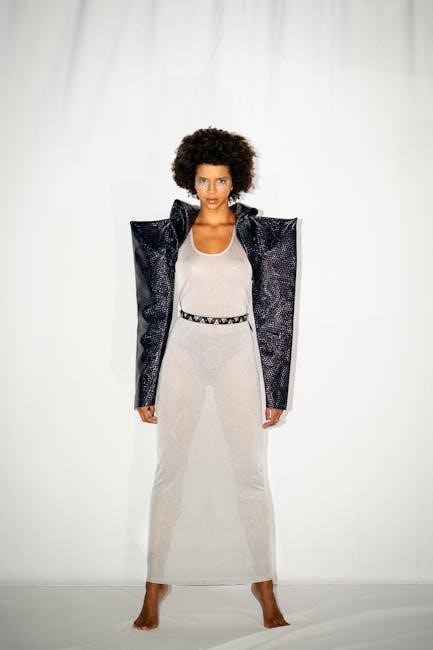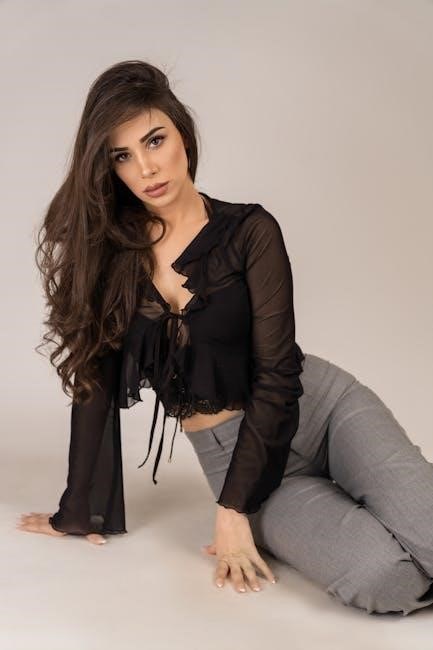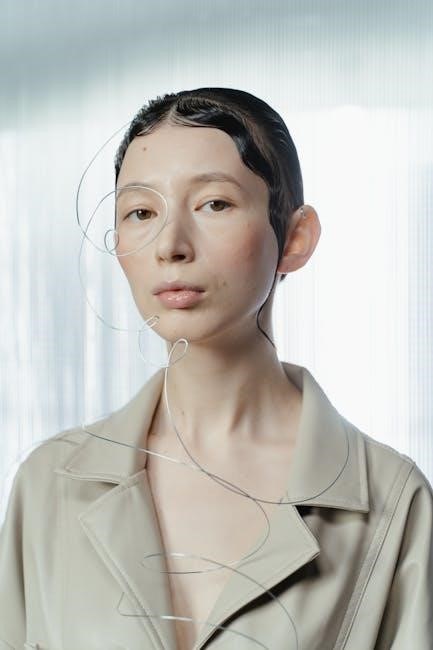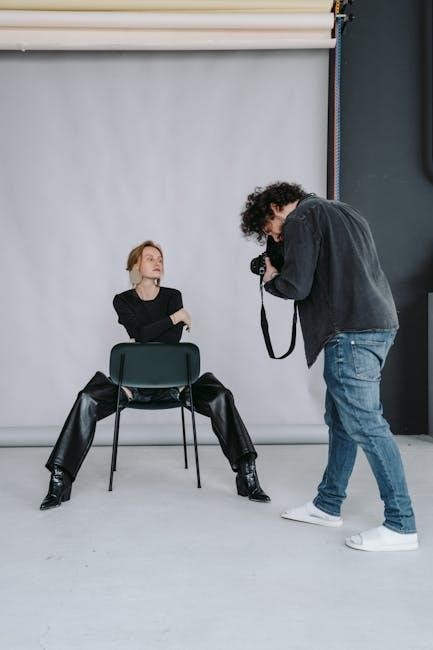Understanding Your Personal Style
Defining your personal style in photography involves exploring your artistic vision‚ experimenting with techniques‚ and curating a cohesive aesthetic that reflects your unique perspective and storytelling approach.
Identifying Your Aesthetic
Identifying your aesthetic in photography involves pinpointing the visual elements and themes that resonate with your creative vision. Start by analyzing your past work to uncover recurring patterns‚ such as color schemes‚ lighting preferences‚ or compositions. Reflect on what inspires you—whether it’s minimalism‚ vibrant contrasts‚ or moody tones. Consider how these elements align with your personal style and the stories you want to tell. Experiment with different techniques to refine your approach‚ and don’t be afraid to evolve as you grow. Your aesthetic is a unique reflection of your perspective‚ so embrace experimentation and consistency to make it unmistakably your own.
Developing Your Unique Voice
Cultivating a distinctive voice in photography requires a deep exploration of your creative identity. Start by experimenting with techniques that resonate with your vision‚ such as unique lighting setups or bold compositions. Study the work of photographers who inspire you‚ analyzing what sets their styles apart. Authenticity is key—your voice should reflect your personal experiences and perspectives. Consistency is also crucial; over time‚ your choices in color‚ tone‚ and subject matter will become hallmarks of your style. Embrace evolution‚ as your voice will naturally grow as you gain experience. By staying true to your artistic instincts and continuously refining your approach‚ you’ll develop a voice that stands out and tells a story only you can share.
Essential Photography Techniques
Mastering lighting‚ composition‚ and angles is crucial. Experiment with shadows‚ use the rule of thirds‚ and explore unique perspectives to elevate your photography and capture compelling stories.
Lighting Techniques
Lighting is a cornerstone of photography‚ shaping mood and depth. Natural light offers soft‚ warm tones‚ while artificial light provides control and dramatic effects. Experiment with backlighting to create silhouettes or sidelighting for defined textures. Diffused light minimizes harsh shadows‚ ideal for portraits. Play with shadows to add mystery or highlight subjects. Layered lighting combines multiple sources for dynamic results. Reflectors and lightboxes enhance illumination. Golden hour offers magical‚ warm tones. Low-key lighting emphasizes darkness for moody aesthetics. High-key lighting brightens scenes for a clean look. Softbox lights reduce harshness‚ while ring lights create flattering‚ shadow-free images. Mastering lighting transforms ordinary shots into extraordinary visual stories‚ capturing emotions and narratives effectively.
Composition and Framing
Composition and framing are vital for creating visually appealing photographs. The rule of thirds divides the frame into nine equal parts‚ placing subjects at intersections for balanced shots. Leading lines guide the viewer’s eye to the focal point. Symmetry and patterns add order and harmony. Framing elements like archways or trees naturally direct attention to the subject. Experiment with angles—low or high perspectives can add drama. Negative space creates simplicity and emphasizes the subject. Crop thoughtfully to eliminate distractions and strengthen the narrative. Play with depth using foreground and background elements. Balanced composition ensures harmony‚ while breaking rules can create dynamic‚ unique images; These techniques help craft engaging‚ storytelling-rich photos that capture attention and evoke emotion.

Model and Scene Styling

- Wardrobe selection should align with the shoot’s theme and model’s persona‚ ensuring authenticity and visual coherence;
- Grooming and accessories enhance the model’s look‚ with attention to detail in hair‚ makeup‚ and jewelry.
- Props and set design create context‚ with items chosen to complement the scene and story being told.
- Scene setup involves arranging lighting‚ backdrops‚ and elements to craft a cohesive and visually appealing environment.
Wardrobe and Grooming
Wardrobe and grooming are critical elements in photography styling‚ as they help convey the model’s personality and the shoot’s theme. Start by selecting outfits that align with the concept‚ ensuring fabrics‚ colors‚ and textures complement the setting. Pay attention to fit—clothes should flatter the model’s silhouette without appearing overly tight or baggy. Grooming is equally important‚ with hair and makeup styled to enhance natural features while avoiding distractions. Details like clean nails‚ subtle accessories‚ and polished shoes can elevate the look. Consider the model’s comfort to ensure authentic expressions. Remember‚ wardrobe and grooming should harmonize with the scene‚ creating a cohesive visual story that captivates the viewer.
Props and Accessories
Props and accessories play a vital role in enhancing the visual narrative of your photographs. They add depth‚ context‚ and emotion to the scene‚ helping to tell a more compelling story. When selecting props‚ choose items that align with the theme and style of the shoot‚ ensuring they complement the model and setting without overpowering them. Accessories like hats‚ jewelry‚ or scarves can add texture and interest‚ while larger props‚ such as vintage furniture or unique objects‚ can create a focal point. Use props thoughtfully to avoid clutter and maintain a balanced composition. The key is to incorporate elements that enhance the mood and draw the viewer’s eye to the subject‚ creating a harmonious and engaging visual experience.
Post-Processing and Editing
Post-processing and editing transform your photos‚ enhancing details‚ correcting colors‚ and refining textures. Mastering tools like Lightroom and Photoshop helps achieve a polished‚ professional finish‚ ensuring your unique style shines through.
Basic Editing Techniques
Mastering basic editing techniques is essential for enhancing your photos. Start with adjusting exposure‚ contrast‚ and brightness to set the tone. Use the rule of thirds and crop tools to refine composition. Balance colors by tweaking white balance and saturation. Sharpen images to add clarity‚ and reduce noise for smoother textures. These foundational steps ensure your photos look polished and professional‚ aligning with your personal style. Practice these techniques regularly to build confidence and consistency in your post-processing workflow.
Advanced Retouching
Advanced retouching techniques elevate your photography by refining details and creating a flawless finish. Use tools like dodge and burn to subtly adjust lighting and shadows‚ enhancing depth and dimension. Frequency separation helps smooth textures while preserving details‚ ideal for portraits. Clone stamp and healing brush tools allow precise removal of blemishes or distractions. For complex edits‚ layer masking and blending modes offer control over specific areas. These techniques ensure your images are polished and professional‚ maintaining a natural aesthetic. Practice advanced retouching to master subtle enhancements that elevate your work without over-editing‚ ensuring your photos remain authentic and aligned with your creative vision.

Inspiration and Growth
Finding inspiration through exploration‚ study‚ and continuous learning is key to growth. Building a portfolio and staying updated with trends help refine your craft and vision.
Finding Inspiration
Finding inspiration is a continuous journey that involves exploring diverse sources such as art‚ nature‚ and the work of other photographers.
Studying the techniques and styles of renowned photographers can spark creativity and influence your unique approach.
Additionally‚ experimenting with different genres and themes allows you to discover what resonates with you personally.
Engaging with online communities and attending workshops can also provide valuable insights and motivation.
By staying curious and open to new experiences‚ you can consistently find fresh ideas to inspire your photography and refine your personal style.
Building a Portfolio

Building a portfolio is essential for showcasing your photography skills and personal style.
Start by selecting a cohesive collection of images that reflect your artistic vision and technical proficiency.
Ensure each piece demonstrates your ability to tell a story or evoke emotion.
Consider organizing your portfolio by themes or projects to highlight your versatility and depth.
Use high-quality platforms like websites or social media to present your work professionally.
Regularly update your portfolio with new pieces that represent your growth and evolving style.
This collection will not only attract potential clients but also serve as a testament to your creative journey and expertise in photography.
